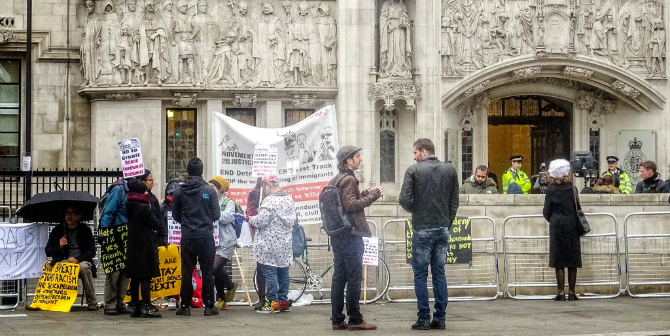 The Scottish government has made a strong case for staying in the single market and the customs union, writes Kirsty Hughes (Scottish Centre on European Relations). It contrasts with the lack of detail from either the UK government or the Opposition – though glosses over the democratic implications of leaving the UK with no say in the running of the single market. But with public opinion in Scotland decisively in favour of Remain, it gives Nicola Sturgeon plenty of manoeuvre if she decides to call for a second independence referendum after the details of Britain’s trade deal emerge.
The Scottish government has made a strong case for staying in the single market and the customs union, writes Kirsty Hughes (Scottish Centre on European Relations). It contrasts with the lack of detail from either the UK government or the Opposition – though glosses over the democratic implications of leaving the UK with no say in the running of the single market. But with public opinion in Scotland decisively in favour of Remain, it gives Nicola Sturgeon plenty of manoeuvre if she decides to call for a second independence referendum after the details of Britain’s trade deal emerge.
The Scottish government’s new paper on Brexit choices – ‘Scotland’s Place in Europe: People, Jobs and Investment’ – makes an important contribution to the UK political debate. It argues that, if the UK is not to follow the best option of staying in the European Union, it should stay in the EU’s single market and in a customs union with the EU.
But what this in-depth 54 page paper does not do is either directly make a case for halting Brexit nor for holding a second independence referendum. The detailed economic analysis in the report shows that a ‘soft’ Brexit of staying in the EU’s single market and customs union is significantly better than a free trade agreement with the EU, let alone simply trading on WTO rules. And it does show that even staying in the European Economic Area would have costs compared to staying in the EU (less so if also in the customs union). But its purpose is to promote the single market option, not to argue to halt Brexit.

A political challenge
The paper provides a robust analysis and estimation of how staying in the EU’s single market and customs union would benefit trade, growth, foreign direct investment, productivity and jobs compared to a Canada-style free trade deal. This then throws down a political challenge to both the UK government and to Labour. The Scottish government has provided a serious in-depth analysis of the costs of different types of Brexit. So where, in that case, is the UK government’s and Labour’s estimates?
The analysis shows – similarly to other independent research – that the costs of having a Canada-style trade deal are substantially higher than staying in the EU’s single market. So while the UK government talks of having a ‘Canada plus plus plus’ deal – to the EU27’s general bemusement – where is its analysis of the costs of either a ‘Canada-dry’ deal or a ‘plus plus plus’ one? So far it doesn’t exist.
And while Labour continues to prevaricate, with Brexit shadow minister Keir Starmer calling again, last weekend, for a deal that has the ‘exact same benefits’ as being in the single market, where is Labour’s detailed analysis showing what that would look like and how it could be achieved?
Special deal for Scotland?
The Scottish government’s paper puts much less emphasis than its first paper in December 2016 did on the differentiated option for Scotland of staying in the EU’s single market and in the UK, if the rest of the UK leaves the single market. It does reference this – not least in the context of the EU-UK provisional deal on Northern Ireland and the fact that one option could still see Northern Ireland having a differentiated deal. But it is dealt with briefly.
What the paper puts much more emphasis on is the goal of devolving immigration policy to Scotland, allowing mitigation of the damaging impact that ending free movement of people will have. An astute UK government, looking to build more positive relations with the Scottish government, might consider some version of that – but there is little to suggest Theresa May’s government might head in that direction.
There are other Scottish twists here. The UK, the paper argues, should stay outside the EU’s common fisheries policy as the EEA countries do. But would the EU accept this – if the UK asked for a closer relationship than any other third country of being in both the single market and customs union? The EU will drive a hard bargain at least on access to fishing waters. The paper is also rather uncertain on what it wants on agriculture – emphasising the benefits to rural communities and agriculture of being in the EU but not quite arguing to stay in the common agricultural policy.
Politically sustainable or democratic?
The key questions in the face of this report are whether its preferred solution is feasible, sustainable or desirable. The Scottish government suggests the whole UK could join/stay in the European Economic Area (EEA). The EU27 – and EEA members – would be open to this in some form, though given the UK’s size, it might be that a separate arrangement would be proposed so as not to unbalance the EEA as it stands. This might anyway be necessary if the UK wanted to be in the EEA and a customs union with the EU (since the EEA members – Norway, Iceland and Liechtenstein – have their own trade policies, sometimes coordinated via EFTA).
But the real challenges here are political and democratic. For the UK to stay in the single market and customs union while giving up its vote, its presence in all relevant EU meetings, and having just a small voice with minimal influence (as Norway has), is the opposite of taking back control. It would create a major democratic deficit. Beyond that, the EU would be bound at times to take decisions on trade policy and on new EU laws and regulations that went against UK and Scottish interests.
These issues are rather glossed over in the paper – though the Scottish government argues that the UK would at least retain some influence in a single market Brexit deal compared to a Canada-style one.
Where now?
Recent polls suggest Scottish support for ‘remain’ is now at 68%, while in England and Wales, opinion is almost 50:50 on ‘remain’ and ‘leave’. The Scottish government’s new paper gives it plenty of political ammunition for debates at Westminster. And, if the UK government does end up with a Canada-style deal, it will also give the Scottish government plenty of room for manoeuvre to demand a second independence referendum if, come the autumn, that is what Nicola Sturgeon decides she wants to go for.
What this paper doesn’t do is give any lead to the 68% who would like to ‘remain’ in the EU. The LibDems – and English and Welsh Greens – remain the only parties calling for a second EU referendum. For now, there is no Scottish government strategy to push the UK towards halting Brexit – which would be in Scotland’s interests even if it did choose independence in the coming years.
To argue for the UK to stay in the EU’s single market and customs union is to argue to stay as close to the status quo as possible while giving up vote, voice and a seat at the table. Faced with a more damaging type of Brexit, it sounds sensible – until you look at the democratic cost. Compared to being an EU member state, it is surely absurd.
This post represents the views of the author and not those of the Brexit blog, nor the LSE. It first appeared at the Scottish Centre for European Relations.
Dr Kirsty Hughes is Director of the Scottish Centre on European Relations. She is a researcher, writer and commentator on European politics and policy, and she previously worked for a number of leading European think tanks.







2nd referendum, 3rd referendum, fourth referendum.. etc. Scotland has zero chance of being heard in the eu anyway. Did greece? Does hungary? Nope. Do as you are told. Art50 has been delivered to the eu. For scotland to be in the eu, it would have to leave the uk, and apply for eu membership. This can be vetoed by other countrys. 1 of 27. Time to stop rehashing old irrelevant arguement, the uk is leaving.
Scotland has zero chance of being heard within the UK , I would rather take my chances on independence no matter how many referendums it takes , to rid ourselves of this parasitical union where we have a corrupt cabal of self serving spivs foisted on us no matter how we vote . With the UK debt running at 1.7 trillion and more austerity being rained on citizens , I defy ANYONE to say this shower of tory incompetents or Liebour or lib dum’s has the ability to run the UK properly
SCOTLAND has been in a supposed equal partnership union ( ha ha ) for over 300 years where the waste monster govt has mismanaged and destroyed any financial or societal credibility they had
SCOTLAND independent from the rest of the UK will make mistakes , but they will be THEIR mistakes and they will rectify those mistakes to benefit the people of Scotland or they will be held accountable
I am not frightened of independence , but I am frightened for my future , my children’s future , and my grandchildren future , under consecutive governments whose ONLY ability is to enrich them and their friends whilst forcing ordinary people in to more poverty and desperation
Did I miss something or has Nicola Sturgeon changed her long-held position that she would much prefer both Scotland and the UK to stay in the EU?
As far as I’m aware the EEA option is something she sees as much less than ideal, but of all the Brexit choices likely to be available the least-worst.
So the conclusion: “Compared to being an EU member state, it (EEA single market and customs union membership) is surely absurd” is a bit of a straw man, put up only to be knocked down with a flourish.
With the latest research suggesting Scotland’s desire to Remain in the EU is wrong (66%) and actually growing the SNP is rightly keen on that outcome. It’s only the fact that ensuring it is not within their power that makes other routes acceptable. Surely this is realpolitik, the absurdity is being generated by another parliament altogether.
Ha! My apologies for the typo-cum-Freudian slip. Scotland’s desire to stay in the EU is strong, not wrong, obviously. Although voters here might be forgiven for feeling there is, in practice, not that much difference. The way the referendum result in Scotland has been ignored by Westminster (and pretty much played down by the Scottish media because…reasons) seems to have rendered our political will inconvenient, if not irrelevant.
Two points.
Short of the UK withdrawing A50, and the EU 27 accepting that, there is no “remain” option available to Scotland. There’s no mechanism for it. Successive Presidents, and the Commission have repeatedly made it clear that Scotland would have to join the EU via the normal A49 process. Which then raises the issue of the timescale. 3-4 years after Independence just to join the EU, with EEA application thereafter. It’s too slow. The idea that some sort of “holding pen” will be specifically devised for Scotland, but then not be available to Catalonia, Corsica etc is not credible, or defensible in a referendum campaign.
Secondly, and absolutely fundamentally, there is not a majority in Scotland for EU membership AND Independence. It’s irrelevant that EU membership is optimal, if we have no realistic way of getting there, short of the UK cancelling Brexit, and the 27 permitting that.
The benefits of Europe are in the single market, not the EU as such. To be in the EEA a state must be in the EU or EFTA. The only realistic option in an acceptable timescale, and which has a chance of garnering a Yes vote in an independence referendum is the latter.
Yes, it’s not as good EU membership in some regards. Although it seems to suit the vast majority of the public in Norway and Iceland very well. But it may be deliverable, and that’s what matters
Agree to some extent Derick but after Brexit these options will not be available. If Brexit goes badly for the UK then it might be that independence, with the option of joining the EU in 5 or 6 years, would become a very acceptable option for most Scots. Currency might become a problem in that scenario and there might, by then, be a massive Breenter campaign ongoing too. One way or another the SNP is right to adopt a “wait-and-see” approach.
Let the scots have referendums every 6 months if they wish.as long as they pay for it. If they vote to leave the union, let them go it alone and join the e.u. rebuild hadrians wall, cut off the free money and bailouts and welfare cheques, copy/ paste australian migration policy for scottish- job done. Let the eu deal with them and let them feel the shafting on their own.
In the EEA with a Norway style deal? Yes please!. In the EU as a full members? Yes Please! – anything rather than stay in the dystopian madhouse run by Westminster. The British dream for the future is longing for the past! Read about the past and weep!
What a load of tosh. Westminster wants the uk to stay in europe. The banks do. Big corporations do, the eu does the torys do for the majority. When you see and witness the shafting of the everyday man due to europe and the impact on jobs and society its not surprising. Hiring foreign workers on the cheap and compressing pay.. its the capitalists dream come true. Well, they havent banned voting yet ( though the common man has zero say in europe so it amounts to the same) brexiteers kicked them in the nuts and good job. I actually emigrated to australia so i could get better work protection and pay, though now brexit is happening i may well return. I have seen europe 1st hand for 19 years as i lived there. Wanna pay cut and job precarity? Join europe and feel the pain.